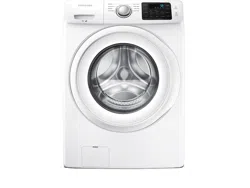Documents: Go to download!
- Owner's manual - (English, French, Spanish)
- Installing your washer
- Operating instructions
- Washing a load of laundry
- Maintaining your washer
- Troubleshooting
Table of contents
User manual Washing Machine
Installing your washer
Unpacking your washer
Unpack your washer and inspect it for shipping damage. Make sure you have received all the items shown below. If your washer was damaged during shipping, or you do not have all of the items, contact 1-800-SAMSUNG (726-7864).
To prevent personal injury or strain, wear protective gloves whenever lifting or carrying the unit.
Packing materials can be dangerous to children. Keep all packing material (plastic bags, polystyrene, etc.) well out of the reach of children.
Overview of your washer
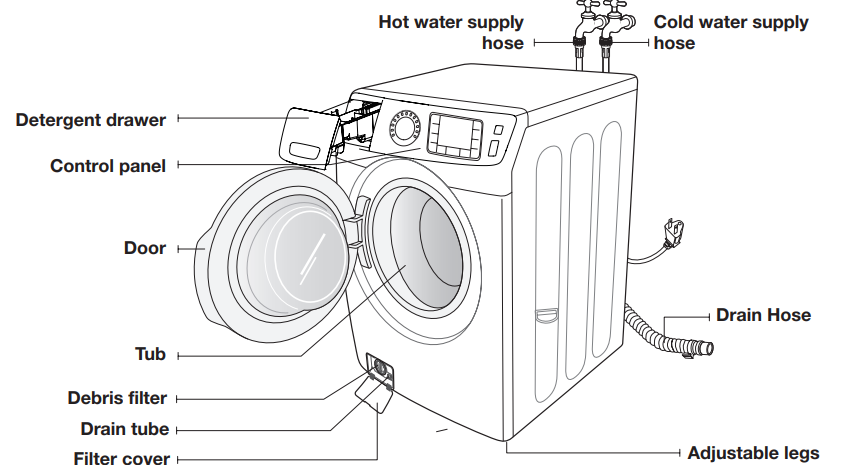
Parts supplied

Tools needed for installation

Parts needed (Sold separately)

- If you lose an accessory and want to purchase a replacement, contact the Samsung service center (1-800-SAMSUNG(1-800-726-7864)).
- The design of the parts and accessories may differ from the pictures above. Their design is subject to change without notice for product improvement.
- Do not reuse old hoses. Only use new water supply hoses when you install the washing machine. Old water supply hoses can leak or burst causing flooding and property damage.
- Confirm that there are rubber washers inside each coupling of the water supply hoses.
Important note to installer
Installation flow chart
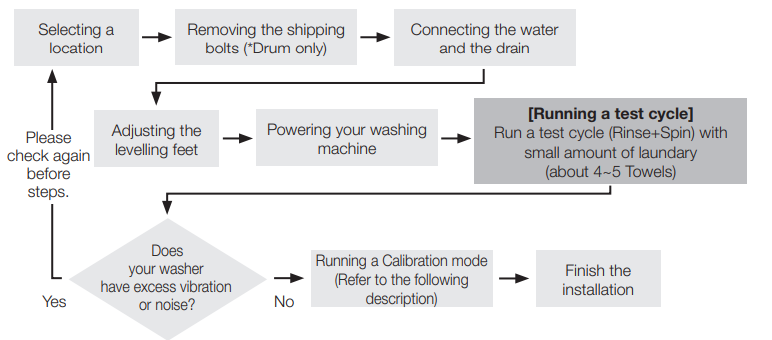
STEP 1 Removing the Shipping Bolts - Before using your washer, you must remove all shipping bolts from the back of the unit.
- Loosen all the bolts with the wrench.
- Slide the bolt and spacer up and remove the bolt with the spacer through the hole in the rear wall of your washer. Repeat for each bolt.
- Cover the holes with the supplied Bolt Hole Covers.
- Keep the shipping bolts and spacers for future use.
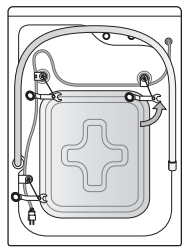
STEP 2 Selecting a Location - Before you install your washer, make sure the location:
- Has a hard, level surface.
- Is away from direct sunlight.
- Has adequate ventilation.
- Will not freeze (tempuratures are never below 32 °F or 0 °C).
- Is away from heat sources such as oil or gas.
- Has enough room for the power cord.
- Doesn’t have any carpeting that will obstruct ventilation openings.
STEP 3 Installing your Washer - To connect the water hoses to the faucets:
1. Connect one end of each water hose to the Hot or Cold tap.
2. Turn the fittings by hand until they are tight, and then tighten them by just an additional two-thirds of a turn with a spanner. Do not overtighten the fittings. You can damage them.
3. When done, pull the water hoses up and down to check if they are properly connected.

4. Put the other ends of the hoses into a bucket and open the taps for 10- 15 seconds to remove impurities. When done, close the taps.

5. Tighten Coupling by hand until it is snug.

6. Then tighten two-thirds of a turn with pliers.

7. Run water in a bowl or basin to get rid of any debris inside hose. Check for HOT and Cold water supply.

8. Connect one end of the COLD/HOT water supply hoses to the each COLD/HOT water supply intakes at the back of the washer.

9. Tighten Coupling by hand until it is snug.

10. Then tighten two-thirds of a turn with pliers.
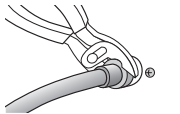
11. For proper operation, make sure both Hot & Cold hoses from faucets are connected to the corresponding Hot / Cold water inlets on the washer.
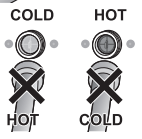
12. Connect the other ends of the water hoses to the corresponding inlets on the rear of the machine as specified. Make sure the hot water hose is connected to the hot inlet, and the cold water hose to the cold inlet.
13. Repeat step 2 above on the other fittings. Make sure both water hoses are connected properly. See the ‘4E’ information code for troubleshooting.
14. Open both faucets, and check if there is a leak
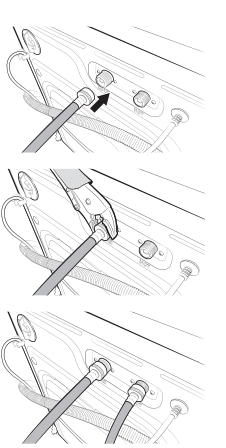
Wall standpipe drain system
1. The drain hose must be placed into a wall standpipe drain system. To keep the end of the drain hose bent, use the supplied hose guide (A). Secure the guide to the wall using a hook to ensure stable drainage.
2. Open the water tap and check if there are any leaks around the connection areas. If there are water leaks, repeat thesteps above.

3. Slide your washer into position.
4. Level the washer by manually adjusting the levelling feet. When your washer is level, tighten the locking nuts using the wrench or (-) flathead screwdriver.
5. Plug the power cord into a 3-Prong, well grounded 120 volt 60 Hz approved electrical outlet protected by a 15-amp fuse or comparable circuit breaker. Your washer is grounded through the third prong of the power cord when plugged into a three-prong grounded receptacle.
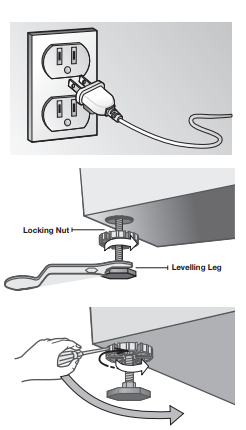
STEP 4 Calibration mode - Your Samsung washing machine automatically detects the weight of the laundry. For more accurate weight detection, please run Calibration Mode after the installation. To run Calibration Mode, follow these steps:
- Turn on the washer.
- Press the Temp. button and Delay End button simultaneously for at least 3 seconds.
- Remove any contents in the tub and close the door.
- Press the Start/Pause button.
- The drum rotates clockwise and counterclockwise for approximately 3 minutes.
- When Calibration Mode is finished, the “En/End” appears on the display and the washing machine turns off automatically. The washing machine is now ready for use.
Operating instructions
Loading your washer
- Fill the tub with dry, unfolded clothes evenly around in order to enhance washing efficiency and prevent excess wear, or wrinkling of the load.
- Wash delicate items such as bras, hosiery, and other lingerie in the Delicates cycle with similar lightweight items.
- When washing big bulky items or a few smaller items that don’t fill the tub completely – a rug, a pillow, stuffed toys, or one or two sweaters, for example – add a few towels to improve tumbling and spin performance.
During the spin cycle, the washer may add additional water to redistribute the clothes and correct an inbalance inside the drum.
- To ensure good cleaning result when washing heavily soiled loads, do not overload your washer.
- When the “
 ” light is ON, you can add or remove laundry items during a wash.
” light is ON, you can add or remove laundry items during a wash.
- Press the Start/Pause Button.
- Wait for the Door Lock light to go out (5 seconds).
- Add the item, close the door, and press the Start/Pause Button. After a 10-second pause, the cycle will resume.
To ensure thorough cleaning, add items within five minutes of starting the wash cycle
Washing clothes: Basic Instructions
- Press the Power button, open the door, and then load the washer.
- Close the door. Push the laundry into the drum completely to prevent the laundry from being caught in the door or from falling out of the drum.
- Add detergent and additives to the dispenser
- Select the appropriate cycle and options for the load
- Press the Start/Pause Button. The drum automatically rotates and measures the weight of the laundry without supplying water in order to adjust the wash time. (The rotating display on the display panel indicates that the weight of the laundry is being measured.)
- The Wash Indicator light will illuminate.
- The estimated cycle time will appear in the display. The time may fluctuate to indicate the time remaining in the cycle better. The actual time required for a cycle may differ from the estimated time in the display depending on the water pressure, water temperature, detergent, and laundry.
- Before your washer starts to fill, it will make a series of clicking noises to check the door lock and do a quick drain.
- When the cycle is complete, the Door Lock light will go out and “End” will appear in the display.
- DO NOT attempt to open the door until the Door Lock light is off. To add a forgotten item, see the “Loading your Washer” section above.
- When your washer is restarted after a pause, expect a delay of up to 15 seconds before the cycle continues.
- Pressing the Power button cancels the cycle and stops your washer.
- The Wash, Rinse, and Spin indicator lights will illuminate during those portions of the cycle.
Washing a load of laundry
Overview of the control panel
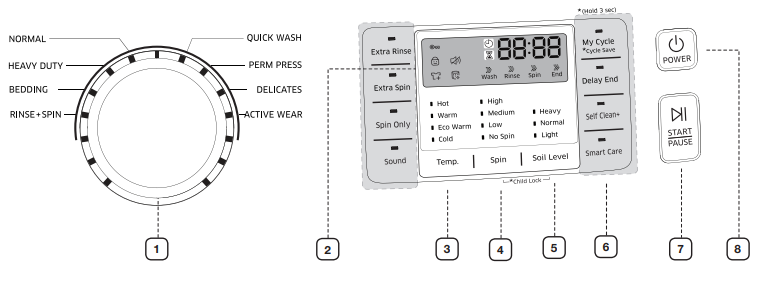
1 Cycle Selector - Select the appropriate cycle for the type of load. This will determine the tumble pattern and spin speed for the cycle.
- NORMAL - For most fabrics including cottons, linens, and normally soiled garments. HEAVY DUTY - For sturdy, colorfast fabrics and heavily soiled garments.
- BEDDING - For bulky items such as blankets, comforters and sheets. When you are washing bulky items, use liquid detergent.
- RINSE + SPIN - Use for loads that need rinsing only or to add rinse-added fabric softener to a load.
- QUICK WASH - For lightly soiled garments needed quickly.
- PERM PRESS - For wash-and-wear, synthetic fabrics, and lightly to normally soiled garments.
- DELICATES - For sheer fabrics, bras, lingerie silk, and other handwash only fabrics. For best results, use liquid detergent.
- ACTIVE WEAR - Use this cycle to wash exercise wear such as sports jerseys, training pants, shirts/tops and other performance clothing. This cycle provides effective soil removal with gentle action for special fabric care.
2 Digital display - The large Digital Display is easy to use. It provides instructions and diagnostics while keeping you updated on the cycle status and time remaining.
3 Temperature selection button - Press the button repeatedly to cycle through the different water temperature options.
- Hot - Whites and heavily soiled, colorfast items.
- Warm - Colorfast items. When warm rinse is selected, only the final rinse will be warm. The other rinses will be cold to conserve energy.
- Eco Warm - Moderately soiled, colorfast items; most wrinkle-free items.
- Cold - Brightly colored, very lightly soiled items.
4 Spin selection button - Press the button repeatedly to cycle through the different spin speed options. (Rins hold (All Lamp Turn Off) -> No Spin -> Low -> Medium -> High )
- High - Use for underwear, t-shirts, jeans and sturdy cottons.
- Medium - Use for jeans, wrinkle-free or wash-and-wear items and synthetics.
- Low - Use for delicate items needing a slow spin speed.
- No Spin - Drains your Washer without spinning. Use for extremely delicate items that cannot tolerate any spin.
- Rinse Hold (All Lamp Turn Off) - The laundry remains soaking in the final rinse water. Either a drain or spin cycle must be performed to unload the laundry.
5 Soil Level selection button - Press the button to select the soil level/washing time. (Light -> Normal -> Heavy)
- Heavy - For heavily soiled loads.
- Normal - For moderately soiled loads. This setting is best for most loads.
- Light - For lightly soiled loads.
6 Select Cycle Option - Press these buttons to select different cycle options.
- Extra Rinse - Add an additional rinse at the end of the cycle to remove laundry additives and perfumes more thoroughly.
- Extra Spin - Add additional time to remove more water from loads.
- Spin Only - The option to start only Spin of each course.
- Sound - When you activate the Sound off function, the “Sound [ ]” lamp illuminates.
- My Cycle - Choose your favorite cycle including temperature, spin, soil level, options, etc.
- Delay End - Any cycle can be delayed for up to 24 hours in one-hour increments. Displayed hour indicates the time at which the wash will be ended.
- Self Clean+ - Use to clean dirt and possible mold from the drum. Regular use (after every 40 washes) is recommended. No detergent or bleach is needed
- Smart Care - This function enables you to check the status of the washing machine using a smartphone.
7 Start/Pause selection button - Press to pause and restart programs.
8 Power button - Press once to turn your washer on, press again to turn your washer off. If the washer is left on for more than 10 minutes without any buttons being touched, the power automatically turns off.
Child Lock 
Child Lock prevents children from playing with your washer.
Once you have activated the Child Lock function, the control panel cannot be activated, preventing children from playing with the washer.
Activating the Child Lock function - Press and hold both the Soil Level and Spin buttons simultaneously for 3 seconds.
- When you activate the Child Lock function, the door locks and the “Child Lock
 ” lamp illuminates.
” lamp illuminates. - If you press the START/PAUSE button after you have activated the Child Lock function , none of the buttons will work except for the POWER button.
- If you press a button when the buttons are locked, the “Child Lock
 ” lamp blinks.
” lamp blinks.
Pausing the Child Lock function - When the door is locked or the buttons are locked by the Child Lock function, you can pause the Child Lock operation for 1 minute by pressing and holding both the Soil Level and Spin buttons simultaneously for approximately 3 seconds.
- If you pause the Child Lock mode temporarily, the door lock is released for 1 minute for user convenience. During this period, the “Child Lock
 ” lamp blinks.
” lamp blinks. - If you open the door after the minute is over, an alarm sounds for up to 2 minutes.
- If you close the door within the 2 minutes, the door is locked and the Child Lock function is reactivated. If you close the door after the 2 minutes, the door is not locked automatically and no alarm sounds.
Deactivating the Child Lock function - Press and hold both the Soil Level and Spin buttons simultaneously for approximately 6 seconds. When you deactivate the Child Lock function, the door is unlocked and the “Child Lock  ” is turned off.
” is turned off.
Garment+ 
You can add or take out laundry items even after the wash has started, as long as the “ ” light is on. Pushing the START/PAUSE button unlocks the door, unless the water is too hot or if there is too much water in your washer. If you are able to unlock the door and wish to continue the wash cycle, close the door, and then press the START/PAUSE button.
” light is on. Pushing the START/PAUSE button unlocks the door, unless the water is too hot or if there is too much water in your washer. If you are able to unlock the door and wish to continue the wash cycle, close the door, and then press the START/PAUSE button.
Delay End
You can set the washing machine to start your wash automatically at a later time, choosing a delay time. The hour displayed indicates the time at which the wash will be ended.
- Set your wash cycles.
- Press the Delay End button repeatedly until the delay time is set.
- Press the START/PAUSE button. The “Delay End ” indicator will be lit, and the clock will begin counting down until it reaches the set time.
- To cancel a Delay End function, press the POWER button and then turn the washing machine on again.
My Cycle
Lets you save a custom wash cycle (temperature, spin, soil level, etc.) and then recall and use it with one button convenience. To save a cycle and selected options as your My Cycle, follow these steps:
- Select the cycle using the Cycle Selector dial.
- After cycle selection, set each option.
- You can then store the selected cycle and options by pressing and holding the My Cycle button for longer than 3 seconds. The cycle and options you select will be displayed the next time you choose the My Cycle function.
- Press the My Cycle button to load and use the saved My Cycle options. The “My Cycle” light will indicate activation. Also, the chosen course and option lights will flicker
Sound
The Sound Off function can be selected during all courses.
Smart Care
This function enables you to check the status of the washing machine using a smartphone.
- To enable the Smart Care function Press Smart Care button to use.
- If the Smart Care function is activated, the LED on the window display rotates for 2 or 3 seconds and then the Smart Care indicator is lit on the display.
- Run the Smart Care app on your smart phone.
- The Smart Care function is optimized with Galaxy and iPhone Series.
- Focus your smart phone’s camera on the display panel of the washing machine.
- If the smart phone’s camera is focused on the display panel of the washing machine, the panel and error message is automatically recognized and the error type and countermeasures are displayed on the smart phone.
- If the smartphone fails to recognize the error code more than twice, please enter the error code displayed on the display panel of the washer manually into the Smart Care app.
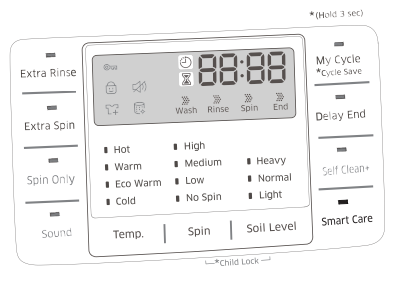
Washing clothes using the cycle selector
Your new washing machine makes washing clothes easy, using Samsung’s “Fuzzy Control” automatic control system. When you select a wash program, the machine will set the correct temperature, washing time, and washing speed.
- Turn on your sink’s water tap.
- Press the Power button.
- Open the door.
- Load the articles of clothing one at a time loosely into the drum, without overfilling it.
- Close the door.
- Add detergent, softener, and pre-wash detergent (if necessary) into the appropriate compartments.
- Use the Cycle Selector to select the appropriate cycle according to the type of material: NORMAL, HEAVY DUTY, BEDDING, SANITIZE, RINSE+SPIN,QUICK WASH, PERM PRESS, DELICATES, ACTIVE WEAR. The relevant indicators will illuminate on the control panel.
- At this time, you can control the wash temperature, the number of rinse cycles, the spinning speed, and the delay time by pressing the appropriate option button.
- Press the Start/Pause button on the Cycle Selector and the wash will begin. The process indicator will light up and the remaining time for the cycle will appear in the display
Pause Option
- Within 5 minutes of starting a wash, it is possible to add/remove laundry items to/from the wash.
- Press the Start/Pause button to unlock the door.
- The door cannot be opened when the water is too HOT or the water level is too HIGH.
- After closing the door, press the Start/Pause button to restart the wash.
When the cycle is finished: After the total cycle has finished, the power will turn off automatically.
- Open the door.
- Remove laundry
ATC (Auto Temperature Control)
ATC is the control function that the washer controls water temperature with temperature sensor (thermistor).
- Because there are numerous water temperatures depending on the customer’s environments ( cold areas, warm areas, various water temperature, settings of heater temperature, etcs), ATC function in our washer maintains the certain level of wash temperature to output the best washing performance at each cycle.
- If you select normal & heavy duty cycles, those cycles are the regulation and UL course. Since new washers must reduce the amount of energy usage at first priority, customers will notice more cold water entering the washer. But This is Normal, not a problem.
- In those regulation cycles, Hot temperature is similar to acceptable adult bath-water temperature and warm temperature is similar to comfortable swimming-pool water temperature. If customers want to wash clothes in specific water temperature, customers should choose a different cycles at each temperature ( Hot/Warm/Eco Warm )
Detergent use
Your Washer is designed to use high efficiency (HE) detergents.
- For best cleaning results, use a high efficiency detergents such as Tide HE, Wisk HE, Cheer HE, or Gain HE*. High efficiency detergents contain suds suppressors that reduce or eliminate suds. When fewer suds are produced, the load tumbles more efficiently and cleaning is maximized. Regular detergent is NOT recommended. Please use HE detergents only.
FEATURES
Automatic dispenser
Your washer has separate compartments for dispensing detergent and color-safe bleach, chlorine bleach, and fabric softener. Add all laundry additives to their respective compartments before starting your washer. The automatic dispenser MUST ALWAYS be in place before you start your washer. DO NOT open the automatic dispenser when your washer is running.
Usage Pointers:
- Never exceed the manufacturer’s recommendations when adding detergent.
- This compartment holds liquid detergent for the main wash cycle, which the washer adds to the load at the beginning of the cycle.
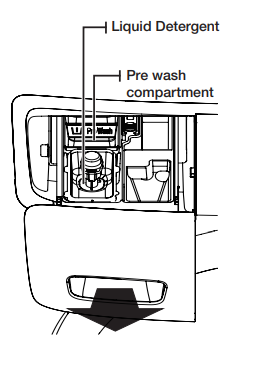
Detergent compartment
- Pour the recommended amount of laundry detergent directly into the detergent compartment before starting your washer.
Bleach compartment (Liquid chlorine bleach only)
- Add chlorine bleach to the bleach compartment. DO NOT exceed the MAX FILL line.
- Avoid splashing or over–filling the compartment.
- Your washer automatically dispenses bleach into the tub at the appropriate time.
- The dispenser automatically dilutes liquid chlorine bleach before it reaches the wash load.
- Never pour undiluted liquid chlorine bleach directly onto the load or into the tub. It is a powerful chemical and can cause fabric damage, such as weakening of the fibers or color loss, if not used properly.
- Oxi-type boosters or color-safe bleach can be added to the drum prior to adding laundry.
- Put the laundry into the drum only after confirming that the oxi-type boosters or color-safe bleach has completely entered the hole of the drum.
- To use powdered detergent and powder oxi-type boosters or powdered color-safe bleach at the same time, it is more effective to put them in the drum together before adding the laundry. When you use powdered detergent, remember to remove the Liquid Detergent holder from the detergent compartment.

Fabric softener compartment
- Pour the recommended amount of liquid fabric softener into the softener compartment. For smaller loads, use less than one capful.
- Dilute the fabric softener with water until it reaches MAX FILL in the compartment.
- The dispenser automatically releases liquid fabric softener at the proper time during the rinse cycle.
- Use the softener compartment ONLY for liquid fabric softeners.
- DO NOT use a Downy Ball* in the Fabric softener compartment of this washer. It will not be added at the appropriate time. Use the detergent compartment.
Maintaining your washer
Cleaning the exterior
Turn off the water faucets after finishing the day’s washing.
This will shut off the water supply to your washer and prevent the unlikely possibility of damage from escaping water. Leave the door open to allow the inside of your washer to dry out.
Use a soft cloth to wipe up all detergent, bleach or other spills as they occur.
Clean the following as recommended below:
Control Panel – Clean with a soft, damp cloth. Do not use abrasive powders or cleaning pads. Do not spray cleaners directly on the panel.
Cabinet – Clean with soap and water.
Cleaning the interior
Clean the interior of your washer periodically to remove any dirt, soil, odor, mold, mildew, or bacterial residue that may remain in your washer as a result of washing clothes.
Failure to follow these instructions may result in unpleasant conditions, including odors and/or permanent stains on your washer or laundry.
Hard water deposits may be removed, if needed. Use a cleaner labeled “Washer safe”.
Cleaning the dispensers
You may need to clean the automatic dispenser periodically to remove laundry additive buildup.
- Pull out the Liquid Detergent holder from the detergent compartment.
- Remove the siphon cap from the fabric softener and bleach compartments.
- Wash all of the parts under running water.
- Clean the dispenser recess with a soft brush.
- Reinsert the siphon cap and push it firmly into place.
- Push the Liquid Detergent holder back into place.
- Run a Rinse+Spin cycle without any load in your washer.

Storing your washer
Washers can be damaged if water is not removed from hoses and internal components before storage. Prepare your washer for storage as follows:
- Select the Quick Wash cycle and add bleach to the automatic dispenser. Run your washer through the cycle without a load.
- Turn the water faucets off and disconnect the inlet hoses.
- Unplug your washer from the electrical outlet and leave your washer door open to let air circulate inside the tumbler.
- If you store your washer in below–freezing temperatures, make sure you allow time for any leftover water in your washer to thaw before use
Cleaning the debris filter
We recommend cleaning the debris filter when water does not drain well or the “5E” error message is displayed.
1. Unplug the washing machine from the power supply.
2. Gently press the top area of the filter cover to open.

3. Holding the drain cap, pull the drain tube that is hooked on the guide hook to the front. Do not pull the drain tube with excessive force.
4. Place a bowl under the washing machine to catch any remaining water. Then, hold the drain tube with one hand, and turn the drain cap counter clockwise with the other hand to separate it from the drain tube.
5. Drain the remaining water completely.
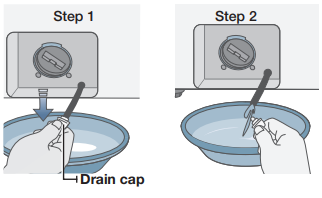
6. Turn the debris cap counterclockwise, and then pull the debris cap and debris filter assembly out of the washer.
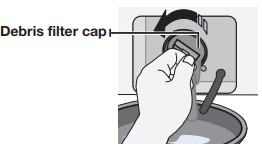
7. Wash any dirt or other material from the debris filter. Make sure the drain pump propeller behind the debris filter is not blocked.
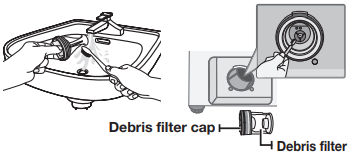
8. When you have finished cleaning the filter, insert the debris cap and filter assembly back into the washer. Turn the debris filter cap clockwise until the indicator on the debris filter cap is in the 12 o’clock position, pointing to the indicator on the washer.
9. Re-attach the emergency drain cap to the drain tube, and then hook the tube to the hook guide.
10. Re-install the filter cover.

Cleaning the door Diaphragm
- Open the washer door and remove any clothing or items from the washer.
- Check if there are any foreign substances on the grey Diaphragm 1 between the lid and the drum. To check this, turn the Diaphragm 2 out.
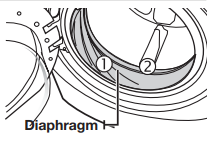
- If there are any foreign substances, remove them.
- If you find stained areas, wipe them down using the procedure below:
- Carefully combine ¾ cup (177 mL) of liquid chlorine bleach with 1 gal. (3.8 L) of warm tap water.
- Wipe the Diaphragm area with the dilute solution using a damp cloth.
- Let stand 5 minutes.
- Wipe down the area thoroughly with a dry cloth and let the washer interior air dry with the door open.
Preserving the top cover and the front frame
Do not place any heavy or sharp objects or a detergent box on the washing machine. They can scratch or damage its top cover. Keep them in the pedestal (if purchased) or in a separate storage box.
Since the entire washing machine has a high-gloss finish, the surface can be scratched or damaged. Avoid scratching or damaging the surface when using the washing machine.
Self Clean+
Self Clean+ is a self-cleaning cycle that removes mold that may occur inside the washing machine.
- Press the Power button.
- Press the Self Clean+ button. Once the Self Clean+ button is pressed, the only function that can be set is Delay End.
- Press the Start/Pause button. When you press the Start/Pause button, Self Clean+ begins.

The Self Clean+ Auto Indicator Function
- If the “Self Clean+” button is lit after a wash, it indicates that tub (drum) cleaning is required. In this case, remove the laundry from the washing machine, turn the power on, and clean the drum by running Self Clean.
- If you do not run Self Clean+ after every 40 washes, the “Self Clean+” indicator turns off after one hour. However, the “Self Clean+” indicator will light again after five washes. Not running Self Clean+ at this point will not cause a problem with the washing machine.
- Although the Self Clean+ Auto Indicator appears once a month or so, the frequency may differ depending on the number of times the washing machine is used.
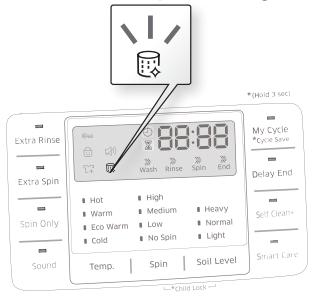
Troubleshooting
Check these solutions if your washer…
Will not start.
- Make sure the door is firmly closed.
- Make sure your washer is plugged in.
- Make sure the water source faucets are open.
- Make sure to press the Start/Pause Button to start your washer.
- Make sure the Child Lock is not activated. See page 22.
- Before your washer starts to fill, it will make a series of clicking noises to check the door lock and do a quick drain.
- Check the fuse or reset the circuit breaker
Has no water or not enough water.
- Turn both faucets on fully.
- Make sure the door is tightly closed.
- Straighten the water inlet hoses.
- Disconnect hoses and clean the screens. Hose filter screens may be clogged.
- Open and close the door, then press the Start/Pause Button.
Has detergent remains in the automatic dispenser after the wash cycle is complete.
- Make sure your washer is running with sufficient water pressure.
- Make sure the Detergent Selector dial is in the upper position when using granular detergent.
Vibrates or is too noisy.
- Make sure your washer is set on a level surface. If the surface is not level, adjust your washer feet to level the appliance.
- Make sure that the shipping bolts are removed.
- Make sure your washer is not touching any other object.
- Make sure the laundry load is balanced.
Stops
- Plug the power cord into a live electrical outlet.
- Check the fuse or reset the circuit breaker.
- Close the door and press the Start/Pause Button to start your washer. For your safety, your washer will not tumble or spin unless the door is closed.
- Before your washer starts to fill, it will make a series of clicking noises to check the door lock and do a quick drain.
- There may be a pause or soak period in the cycle. Wait and it may start.
- Check the screens on the inlet hoses at the faucets for obstructions.
- Clean the screens periodically.
Fills with the wrong temperature water.
- Turn both faucets on fully.
- Make sure the temperature selection is correct.
- Make sure the hoses are connected to the correct faucets.
- Flush water lines.
- Check the water heater. It should be set to deliver a minimum 120 °F (49 °C) hot water at the tap. Also check the water heater capacity and recovery rate.
- Disconnect the hoses and clean the screens. The hose filter screens may be plugged.
- As your washer is filling, the water temperature may change as the automatic temperature control feature checks incoming water temperature. This is normal.
- While your washer is filling, you may notice just hot and/or just cold water going through the dispenser when you have selected cold or warm wash temperatures. This is a normal function of the automatic temperature control feature as your washer determines the temperature of the water.
Door locked or will not open.
- Press the Start/Pause Button to stop your washer.
- Your washer door will remain locked during the heating portion of the
- Sanitize Cycle
- It may take a few moments for the door lock mechanism to disengage.
Does not drain and/or spin.
- Check the fuse or reset the circuit breaker.
- Straighten the drain hoses. Eliminate kinked hoses. If there is a drain restriction, call for service.
- Close the door and press the Start/Pause Button. For your safety, your washer will not tumble or spin unless the door is closed.
- Make sure the debris filter is not clogged.
Load is too wet at the end of the cycle.
- Use the High or Extra High spin speed.
- Use high-efficiency detergent to reduce over–sudsing.
- The load is too small. Very small loads (one or two items) may become unbalanced and not spin out completely.
Leaks water.
- Make sure the door is firmly closed.
- Make sure all hose connections are tight.
- Make sure the end of the drain hose is correctly inserted and secured to the drainage system.
- Avoid overloading.
- Use high-efficiency detergent to prevent over–sudsing.
Has excessive suds.
- Use high-efficiency detergent to prevent over-sudsing.
- Reduce the detergent amount for soft water, small or lightly soiled loads.
- Non-HE detergent is NOT recommended.
Has an odor.
- Excessive suds collect in nooks and crannies and can cause foul odors.
- Run cleansing cycles to sanitize the machine periodically. (Sanitize
- Cycle or Self Clean+)
- Clean the door seal (Diaphragm).
- Dry the interior of your washer after the total cycle has finished.
Information codes - Error Codes
Error UE
- Unbalanced load prevented your washer from spinning.
- Redistribute the load, and press the Start/Pause button.
Error dE
- The door is open when the washer is running.
- Close the door tightly and restart the cycle. If the code reappears, call customer service.
Error dE1
- Your washer failed to lock or unlock the door.
Error HE
- A water temperature control problem. (Heater control problem)
- Call customer service.
Error LE
- Your washer has tried to fill, but has not reached the proper water level. Call customer service.
- When washer displays “LE”, washer do draining for 3 minutes. At this time, the Power button is invalid.
Error 5E
- Your washer is not draining. This can also mean that the unit senses a small clog while draining.
- Turn off the unit for 10 seconds and then turn it on again.
- Select the Spin Only cycle.
- Press the Start/Pause to drain the water.
If it still does not drain, call for service.
Error 4E
- Your washer has tried to fill but was unsuccessful.
- Make sure the water faucets are open all the way. Check for bent hoses.
- Check the inlet screens on the hoses. If you are using a Flood Safety Device, please remove the device and connect the water hoses directly to the unit. Check if the hot water supply hose is connected.
- You must connect the hot water supply hose because hot water is supplied by the Auto Temperature Control (A.T.C.) function if the temperature of the cold water is lower than 59°F.
- When washer displays “4E”, washer do draining for 3 minutes. At this time, the Power button is invalid.
Error 4E2
- The hot/cold water hose connection is not correct.
- Please connect the hot/cold water hose connection correctly.
Error OE
- A fault is detected in the water level sensor. Call customer service.
Error 1E
- The Water Level sensor is not working properly. Call customer service.
- When washer displays “1E”, washer do draining for 3 minutes,At this time, Power button is invalid
Error BE2
- A jammed key. Call customer service.
Error tE1
- A temperature sensor problem.
- Restart the cycle. If the code reappears, call customer service.
Error 3E
- A motor problem. Restart the cycle. If the code reappears, call customer service
Error 9E1/9E2
- High/Low voltage detected.
- Restart the cycle. If the code reappears, call customer service.
Error AE
- A Communication error between the SUB(Sensor) PBA and the MAIN PBA Call customer service.
Error AE8
- A Communication error between the MAIN PBA and the INVERTER PBA. Call customer service.
Error 8E
- A MEMS sensor problem. Call customer service.
Error SF1, SF2, SF3
- A system error. Call customer service.
Error SUd
- Too many suds are detected during the wash session. The unit is put on hold until the amount of suds have been reduced. The unit will then go back to operating.
See other models: WF45N5300AV/US ME21K7010DS/A2 DW80K7050US/AA DW80J3020US/AA RF30KMEDBSG/AA
